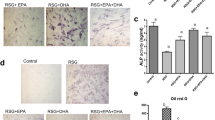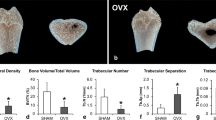Abstract
Thiazolidinediones (TZD), a class of anti-diabetic drugs, determine bone loss and increase fractures particularly in post-menopausal women, thus suggesting a protective role of sex steroids. We have previously demonstrated that the TZD rosiglitazone (RGZ) negatively affects bone mass by inhibiting osteoblastogenesis, yet inducing adipogenesis, in bone marrow-derived human mesenchymal stem cells (hMSC). The aim of this study was to determine whether estrogens and androgens are able to revert the effects of RGZ on bone. hMSC express estrogen receptor a and β and the androgen receptor. We found that 17β-estradiol (10 nM), the phytoestrogen genistein (10 nM), testosterone (10 nM) and the non-aromatizable androgens dihydrotestosterone (10 nM) and methyltrienolone (10 nM) effectively counteracted the adipogenic effect of RGZ (1 µM) in hMSC induced to differentiate into adipocytes, as determined by evaluating the expression of the adipogenic marker peroxisome proliferator-activated receptor γ and the percentage of fat cells. Furthermore, when hMSC were induced to differentiate into osteoblasts, all the above-mentioned molecules and also quercetin, another phytoestrogen, significantly reverted the inhibitory effect of RGZ on the expression of the osteogenic marker osteocalcin and decreased the number of fat cells observed after RGZ exposure. Our study represents, to our knowledge, the first demonstration in hMSC that androgens, independently of their aromatization, and estrogens are able to counteract the negative effects of RGZ on bone. Our data, yet preliminary, suggest the possibility to try to prevent the negative effects of TZD on bone, using steroid receptor modulators, such as plant-derived phytoestrogens, which lack evident adverse effects.
Similar content being viewed by others
References
Schwartz AV, Sellmeyer DE, Vittinghoff E, et al. Thiazolidinedione use and bone loss in older diabetic adults. J Clin Endocrinol Metab 2006, 91: 3349–54.
Grey A, Bolland M, Gamble G et al. The peroxisome proliferatorsactivated receptor-γ agonist rosiglitazone decreases bone formation and bone mineral density in healthy postmenopausal women: a randomized, controlled trial. J Clin Endocrinol Metab 2007, 92: 1305–10.
Gruntmanis U, Fordan S, Ghayee HK, et al. The peroxisome proliferator-activated receptor-gamma agonist rosiglitazone increases bone resorption in women with type 2 diabetes: a randomized, controlled trial. Calcif Tissue Int. 2010, 86: 343–9.
Kahn SE, Haffner SM, Heise MA, et al; ADOPT Study Group, Glycemic durability of rosiglitazone, metformin, or glyburide monotherapy. N Engl J Med 2006, 355: 2427–43.
Dormuth CR, Carney G, Carleton B, Bassett K, Wright JM Thiazolidinediones and fractures in men and women. Arch Intern Med 2009, 169: 1395–402.
Mancini T, Mazziotti G, Doga M, et al. Vertebral fractures in males with type 2 diabetes treated with rosiglitazone. Bone 2009, 45: 784–8.
Douglas IJ, Evans SJ, Pocock S, Smeeth L. The risk of fractures associated with thiazolidinediones: a self-controlled case-series study. PLoS Med 2009, 6: e1000154.
Bilik D, McEwen LN, Brown MB, et al Thiazolidinediones and fractures: evidence from translating research into action for diabetes. J Clin Endocrinol Metab. 2010, 95: 4560–5.
Habib ZA, Havstad SL, Wells K, et al. Thiazolidinedione use and the longitudinal risk of fractures in patients with type 2 diabetes mellitus. J Clin Endocrinol Metab 2010, 95: 592–600.
Sorocéanu MA, Miao D, Bai XY, Su H, Goltzman D, Karaplis AC. Rosiglitazone impacts negatively on bone by promoting osteblast/osteocyte apoptosis. J Endocrinol 2004, 183: 203–16.
AN AA, Weinstein RS, Stewart SA, Parfitt AM, Manolagas SC, Jilka RL. Rosiglitazone causes bone loss in mice by suppressing osteoblast differentiation and bone formation Endocrinology 2005, 146: 1226–35.
Lecka-Czernik B Bone loss in diabetes: use of antidiabetic thiazolidinediones and secondary osteoporosis. Curr Osteoporos Rep 2010, 8: 178–84.
Viccica G, Francucci CM, Marcocci C. The role of PPARγforthe osteoblastic differentiation. J Endocrinol Invest 2010, 33 (7 Suppl): 9–12.
Benvenuti S, Cellai I, Luciani P et al. Rosiglitazone stimulates adipogenesis and decreases osteoblastogenesis in human mesenchymal stem cells. J Endocrinol Invest 2007, 30: RC26–30.
Gurkan UA, Akkus O. The mechanical environment of bone marrow: a review. Ann Biomed Eng 2008, 36: 1978–91.
Singh R, Artaza JN, Taylor WE, Gonzalez-Cadavid NF, Bhasin S. Androgens stimulate myogenic differentiation and inhibit adipogenesis in C3H 10T/2 pluripotent cells through an androgen receptor-mediated pathway. Endocrinology 2003, 144: 5081–8.
Gupta V, Bhasin S, Guo W, et al. Effects of dihydrotestosterone on differentiation and proliferation of human mesenchymal stem cells and preadipocytes. Mol Cell Endocrinol 2008, 296: 32–40.
Benvenuti S, Saccardi R, Luciani P, et al. Neuronal differentiation of human mesenchymal stem cells: changes in the expression of the Alzheimer’s disease-related gene seladin-1. Exp Cell Res 2006, 312: 2592–04.
Pittenger MF, Mackay AM, Beck SC, et al. Multilineage potential of adult human mesenchymal stem cells. Science 1999, 284: 143–7.
Dominici M, Le Blanc K, Mueller I, et al. Minimal criteria for defining multipotent mesenchymal stromal cells. The International Society for Cellular Therapy position statement. Cytotherapy 2006, 8: 315–7.
Venken K, Callewaert F, Boonen S, Vanderschueren D. Sex hormones, their receptors and bone health. Osteoporos Int 2008, 19: 1517–25.
Imai Y, Kondoh S, Kouzmenko A, Kato S. Regulation of bone metabolism by nuclear receptors. Mol Cell Endocrinol 2009, 310: 3–10.
Vandenput L, Ohlsson C. Estrogens as regulators of bone health in men. Nat Rev Endocrinol 2009, 5: 437–43.
Vanderschueren D, Gaytant J, Boonen S, Venken K Androgens and bone. Curr Opin Endocrinol Diabetes Obes 2008, 15: 250–4.
Vanderschueren D, Vandenput L, Boonen S, Lindberg MK, Bouillon R, Ohlsson C. Androgens and bone. Endocr Rev 2004, 25: 389–425.
Patisaul HB. Phytoestrogen action in the adult and developing brain. J Neuroendocrinol 2005, 17: 57–64.
Dang ZC, Audinot V, Papapoulos SE, Boutin JA, Löwik CW. Peroxisome proliferator-activated receptor gamma (PPARgamma) as a molecular target for the soy phytoestrogen genistein. J Biol Chem 2003, 278: 962–7.
Heim M, Frank O, Kampmann G, et al. The phytoestrogen genistein enhances osteogenesis and represses adipogenic differentiation of human primary bone marrow stromal cells. Endocrinology 2004, 145: 848–59.
Hirota K, Morikawa K, Hanada H, et al. Effect of genistein and daidzein on the proliferation and differentiation of human preadipocyte cell line. J Agric Food Chem 2010, 58: 5821–7.
Park HJ, Della-Fera MA, Hausman DB, Rayalam S, Ambati S, Baile CA. Genistein inhibits differentiation of primary human adipocytes. The Journal of Nutritional Biochemistry 2009, 20: 140–8.
Berberoglu Z, Yazici AC, Demirag NG. Effects of rosiglitazone on bone mineral density and remodelling parameters in Postmenopausal diabetic women: a 2-year follow-up study. Clin Endocrinol (Oxf) 2010, 73: 305–12.
Zhao L, Brinton RD. WHI and WHIMS follow-up and human studies of soy isoflavones on cognition. Expert Rev Neurother 2007, 7: 1549–64.
Jacobs A, Wegewitz U, Sommerfeld C, Grossklaus R, Lampen A. Efficacy of isoflavones in relieving vasomotor menopausal symptoms — A systematic review. Mol Nutr Food Res 2009, 53: 1084–97.
Coxam V. Phyto-oestrogens and bone health. Proc Nutr Soc 2008, 67: 184–95.
Atmaca A, Kleerekoper M, Bayraktar M, Kucuk O. Soy isoflavones in the management of postmenopausal osteoporosis. Menopause 2008, 15: 748–57.
Tempfer CB, Froese G, Heinze G, Bentz EK, Hefler LA, Huber JC. Side effects of phytoestrogens: a meta-analysis of randomized trials. Am J Med 2009, 122: 939–46.
Compston JE Sex steroids and bone. Physiol Rev 2001, 81: 419–47.
Kawano H, Sato T, Yamada T, et al. Suppressive function of androgen receptor in bone resorption. Proc Natl Acad Sci USA 2003, 100: 9416–21.
Habib ZA, Havstad SL, Wells K, Divine G, Pladevall, Williams LK Thiazolidinedione use and the longitudinal risk of fractures in patients with type 2 diabetes mellitus. J Clin Endocrinol Metab 2010; 95: 592–600.
Author information
Authors and Affiliations
Corresponding author
Additional information
Prof. Mario Serio, our constant source of inspiration, suddenly passed out very recently. This manuscript is dedicated to his memory.
Rights and permissions
About this article
Cite this article
Benvenuti, S., Cellai, I., Luciani, P. et al. Androgens and estrogens prevent rosiglitazone-induced adipogenesis in human mesenchymal stem cells. J Endocrinol Invest 35, 365–371 (2012). https://doi.org/10.3275/7739
Accepted:
Published:
Issue Date:
DOI: https://doi.org/10.3275/7739




